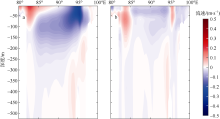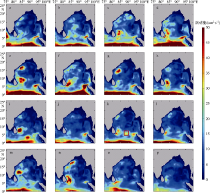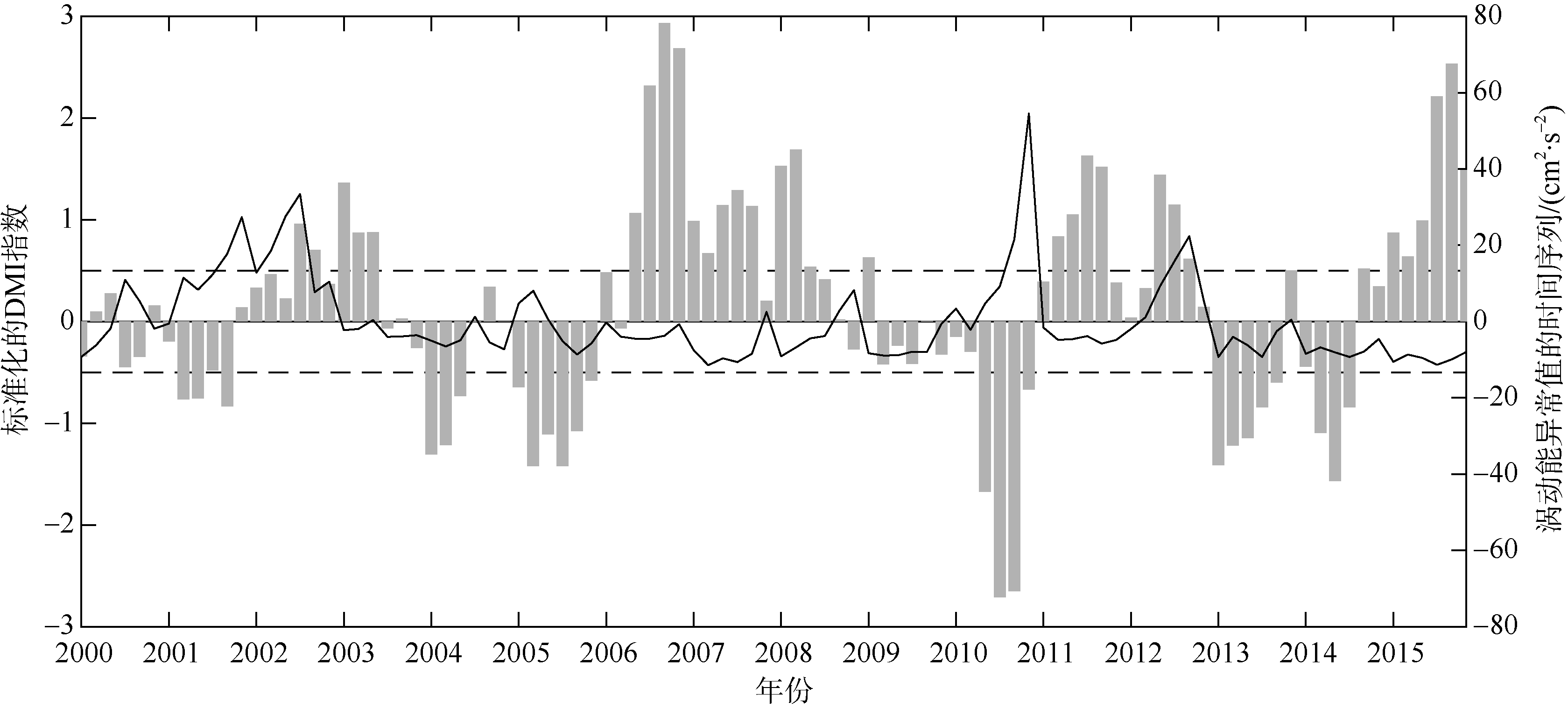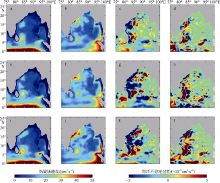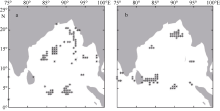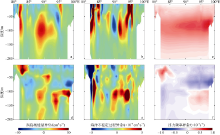Journal of Tropical Oceanography ›› 2020, Vol. 39 ›› Issue (2): 11-14.doi: 10.11978/2019047CSTR: 32234.14.2019047
• Marine Physics • Previous Articles Next Articles
Energy characteristics of eddy-mean flow interaction in the estuary of Bay of Bengal in summer and autumn during 2000-2015
Zhou LE1( ), Ke HUANG2, Subrahmanyam Mantravadi Venkata1(
), Ke HUANG2, Subrahmanyam Mantravadi Venkata1( )
)
- 1. School of Marine Science and Technology, Zhejiang Ocean University, Zhoushan 316022, China
2. State Key Laboratory of Tropical Oceanography (South China Sea Institute of Oceanology, Chinese Academy of Sciences), Guangzhou 510301, China;
-
Received:2019-05-10Revised:2019-06-11Online:2020-03-10Published:2020-03-10 -
Supported by:National Nature Science Foundation of China(41706027);Opening Project of Key Laboratory of Marine Environmental Information Technology, State Oceanic Administration of China(KLMEITKFXM)
CLC Number:
- P731.27
Cite this article
Zhou LE, Ke HUANG, Subrahmanyam Mantravadi Venkata. Energy characteristics of eddy-mean flow interaction in the estuary of Bay of Bengal in summer and autumn during 2000-2015[J].Journal of Tropical Oceanography, 2020, 39(2): 11-14.
share this article
Add to citation manager EndNote|Reference Manager|ProCite|BibTeX|RefWorks

Fig. 1
Summer and autumn averaged spatial distribution of EKE in the Bay of Bengal and its time series from 2000 to 2015, based on SODA (a), OSCAR (b) and AVISO (c) data, respectively. EKE time series averaged in the Bay of Bengal (80°-100°E, 3°-22°N) of those data (d), Filtered result of the time series in (d) on the interannual time scale (2~8 years) (e)"


Fig. 6
Surface wind field and sea surface height anomaly in Bay of Bengal of Climatic mean state (a) and composed by positive IOD years (b), negative IOD years (c). Colourful maps are sea surface height anomaly, vectors correspond to wind speed on 1000 hPa isobaric surface in figure (a) and wind speed anomaly in figure (b) and (c), the arrow in the upper right corner corresponds to wind speed of 3 m·s-1"


Fig. 8
Map of 2010 wind anomaly (vector) on 1000 hPa over the Bay of Bengal and sea surface height anomaly (shading) (a). The arrow at the upper-right corner corresponds to wind speed of 3 m·s-1. (b) and (c) correspond to summer and autumn averaged zonal and meridional velocity anomalies along 6°N in 2010"
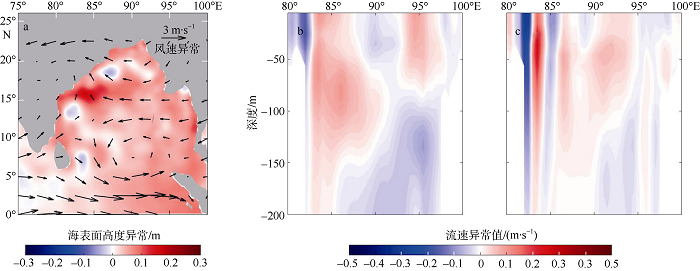
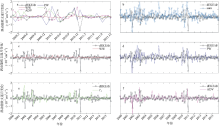
Fig. 10
Monthly time series of all terms in EKE equation in CR area from 2009 to 2011 (a), and monthly time series comparison between the sum of all EKE equation terms and EKE change in CR area from 2000 to 2015 (b). Monthly time series comparison between every single EKE equation term and EKE change in CR area from 2000 to 2015 (c~f)"

| 1 | 李晗, 王强, 黄科 , 等, 2017. 1992—2011年夏季南海西部离岸流区涡流相互作用特征[J]. 海洋与湖沼, 48(5):912-925. |
| LI HAN, WANG QIANG, HUANG KE, et al, 2017. Characteristics of eddy-mean flow interaction in the offshore current area of western South China Sea[J]. Oceanologia et Limnologia Sinica, 48(5):912-925 (in Chinese with English abstract). | |
| 2 | 邱云, 李立 , 2007. 孟加拉湾上层地转环流周年变化的遥感研究[J]. 海洋学报, 29(3):39-46 . |
| QIU YUN, LI LI, 2007. Annual variation of geostrophic circulation in the Bay of Bengal observed with TOPEX/Poseidon altimeter data[J]. Acta Oceanologica Sinica, 29(3):39-46 (in Chinese with English abstract). | |
| 3 | 王天宇, 杜岩, 庄伟 , 等, 2015. 热带西太平洋和南印度洋近20年来的海面高度变化及其动力联系[J]. 中国科学: 地球科学, 45(5):665-675. |
| WANG T Y, DU Y, ZHUANG W, et al, 2015. Connection of sea level variability between the tropical western Pacific and the southern Indian Ocean during recent two decades[J]. Science China: Earth Sciences, 45(5):665-675(in Chinese with English abstract). | |
| 4 | ANNAMALAI H, LIU PING, XIE SHANG-PING , 2005. Southwest Indian Ocean SST variability: its local effect and remote influence on Asian monsoons[J]. Journal of Climate, 18(20):4150-4167. |
| 5 | BÖNING C W, BUDICH R G , 1992. Eddy dynamics in a primitive equation model: sensitivity to horizontal resolution and friction[J]. Journal of Physical Oceanography, 22(4):361-381. |
| 6 | BONJEAN F, LAGERLOEF G S E , 2002. Diagnostic model and analysis of the surface currents in the tropical Pacific Ocean[J]. Journal of Physical Oceanography, 32(10):2938-2954. |
| 7 | CARTON J A, GIESE B S , 2008. A reanalysis of ocean climate using Simple Ocean Data Assimilation (SODA)[J]. Monthly Weather Review, 136(8):2999-3017. |
| 8 | CHEN GENGXIN, WANG DONGXIAO, HOU YIJUN , 2012. The features and interannual variability mechanism of mesoscale eddies in the Bay of Bengal[J]. Continental Shelf Research, 47:178-185. |
| 9 | CHEN GENGXIN, HAN WEIQING, LI YUANLONG , et al, 2017. Strong intraseasonal variability of meridional currents near 5°N in the Eastern Indian Ocean: characteristics and causes[J]. Journal of Physical Oceanography, 47(5):979-998. |
| 10 | CHEN GENGXIN, LI YUANLONG, XIE QIANG , et al, 2018. Origins of eddy kinetic energy in the bay of Bengal[J]. Journal of Geophysical Research: Oceans, 123(3):2097-2115. |
| 11 | CHENG XUHUA, XIE SHANG-PING, MCCREARY J P , et al, 2013. Intraseasonal variability of sea surface height in the Bay of Bengal[J]. Journal of Geophysical Research: Oceans, 118(2):816-830. |
| 12 | CHENG XUHUA, MCCREARY J P, QIU BO , et al, 2017. Intraseasonal-to-semiannual variability of sea-surface height in the astern, equatorial Indian Ocean and southern Bay of Bengal[J]. Journal of Geophysical Research: Oceans, 122(5):4051-4067. |
| 13 | CLARKE A J, LIU X , 1994. Interannual sea level in the northern and eastern Indian Ocean[J]. Journal of Physical Oceanography, 24(6):1224-1235. |
| 14 | DONG CHANGMING, LIN XIAYAN, LIU Y , et al, 2012. Three-dimensional oceanic eddy analysis in the Southern California Bight from a numerical product[J]. Journal of Geophysical Research: Oceans, 117(C7): C00H14. |
| 15 | GENG WU, XIE QIANG, CHEN GENGXIN , et al, 2016. Numerical study on the eddy-mean flow interaction between a cyclonic eddy and Kuroshio[J]. Journal of Oceanography, 72(5):727-745. |
| 16 | HE ZHIGANG, WANG DONGXIAO, HU JIANYU , 2002. Features of eddy kinetic energy and variations of upper circulation in the South China Sea[J]. Acta Oceanologica Sinica, 21(2):305-314. |
| 17 | HEYWOOD K J, MCDONAGH E L, WHITE M A , 1994. Eddy kinetic energy of the North Atlantic subpolar gyre from satellite altimetry[J]. Journal of Geophysical Research: Oceans, 99(C11):22525-22539. |
| 18 | IVCHENKO V O, TREGUIER A M, BEST S E , 1997. A kinetic energy budget and internal instabilities in the fine resolution Antarctic model[J]. Journal of Physical Oceanography, 27(1):5-22. |
| 19 | KALNAY E, KANAMITSU M, KISTLER R , et al, 1996. The NCEP/NCAR 40-year reanalysis project[J]. Bulletin of the American Meteorological Society, 77(3):437-472. |
| 20 | LIANG JUNHONG, MCWILLIAMS J C, KURIAN J , et al, 2012. Mesoscale variability in the northeastern tropical Pacific: Forcing mechanisms and eddy properties[J]. Journal of Geophysical Research, 117(C7). |
| 21 | MCCREARY J P, KUNDU P K, MOLINARI R L , 1993. A numerical investigation of dynamics, thermodynamics and mixed-layer processes in the Indian Ocean[J]. Progress in Oceanography, 31(3):181-244. |
| 22 | POTEMRA J T, LUTHER M E, O’BRIEN J J , 1991. The seasonal circulation of the upper ocean in the Bay of Bengal[J]. Journal of Geophysical Research: Oceans, 96(C7):12667-12683. |
| 23 | QIU BO , 1999. Seasonal eddy field modulation of the North Pacific subtropical countercurrent: TOPEX/Poseidon observations and theory[J]. Journal of Physical Oceanography, 29(10):2471-2486. |
| 24 | RAO R R, KUMAR M S G, RAVICHANDRAN M , et al, 2010. Interannual variability of Kelvin wave propagation in the wave guides of the equatorial Indian Ocean, the coastal Bay of Bengal and the southeastern Arabian Sea during 1993-2006[J]. Deep Sea Research Part I: Oceanographic Research Papers, 57(1):1-13. |
| 25 | RICHARDSON P L , 1983. Eddy kinetic energy in the North Atlantic from surface drifters[J]. Journal of Geophysical Research: Oceans, 88(C7):4355-4367. |
| 26 | SAJI N H, GOSWAMI B N, VINAYACHANDRAN P N , et al, 1999. A dipole mode in the tropical Indian Ocean[J]. Nature, 401(6751):360-363. |
| 27 | SCHOTT F A, MCCREARY JR J P , 2001. The monsoon circulation of the Indian Ocean[J]. Progress in Oceanography, 51(1):1-123. |
| 28 | SCHOTT F A, XIE SHANG-PING, MCCREARY JR J P , 2009. Indian Ocean circulation and climate variability[J]. Reviews of Geophysics, 47(1): RG1002. |
| 29 | SHANKAR D, MCCREARY J P, HAN W , et al, 1996. Dynamics of the East India coastal current: 1. Analytic solutions forced by interior Ekman pumping and local alongshore winds[J]. Journal of Geophysical Research: Oceans, 101(C6):13975-13991. |
| 30 | VINAYACHANDRAN P N, KAGIMOTO T, MASUMOTO Y , et al, 2005. Bifurcation of the East India coastal current east of Sri Lanka[J]. Geophysical Research Letters, 32(15):L15606. |
| 31 | WEBSTER P J, MOORE A M, LOSCHNIGG J P , et al, 1999. Coupled ocean-atmosphere dynamics in the Indian Ocean during 1997-98[J]. Nature, 401(6751):356-360. |
| 32 | WYRTKI K, MAGAARD L, HAGER J , 1976. Eddy energy in the oceans[J]. Journal of Geophysical Research, 81(15):2641-2646. |
| 33 | YANG GUANG, WANG FAN, LI YUANLONG , et al, 2013. Mesoscale eddies in the northwestern subtropical Pacific Ocean: statistical characteristics and three-dimensional structures[J]. Journal of Geophysical Research: Oceans, 118(4):1906-1925. |
| 34 | YOSHIDA S, QIU BO, HACKER P , 2010. Wind-generated eddy characteristics in the lee of the island of Hawaii[J]. Journal of Geophysical Research, 115, C03019. |
| 35 | YU LISAN, O'BRIEN J J, YANG JIAYAN , 1991. On the remote forcing of the circulation in the Bay of Bengal[J]. Journal of Geophysical Research: Oceans, 96(C11):20449-20454. |
| 36 | ZHENG SHAOJUN, FENG MING, DU YAN , et al, 2018. Interannual variability of Eddy Kinetic Energy in the subtropical Southeast Indian Ocean associated with the El Niño-Southern Oscillation[J]. Journal of Geophysical Research: Oceans, 123(2):1048-1061. |
| 37 | ZU TINGTING, WANG DONGXIAO, YAN CHANGXIANG , et al, 2013. Evolution of an anticyclonic eddy southwest of Taiwan[J]. Ocean Dynamics, 63(5):519-531. |
| [1] | HAN Dingyan, LI Min, HU Rui, XIE Lingling. Variation and mechanisms of autumn tropical cyclones landed in Guangdong [J]. Journal of Tropical Oceanography, 2024, 43(1): 64-78. |
| [2] | MA Yu, WANG Weiqiang, YOU Qinglong, XIN Hongyu. The evolution and energy characteristics of the Sri Lanka Dome* [J]. Journal of Tropical Oceanography, 2023, 42(5): 1-16. |
| [3] | ZHANG Lanlan, CHENG Xiawen, XIANG Rong, QIU Zhuoya, CHANG Hu. Changes of radiolarian community structure with depth in the central Bay of Bengal in spring 2019 [J]. Journal of Tropical Oceanography, 2023, 42(4): 166-175. |
| [4] | XU Yikai, HU Song, ZHU Yuhang, WANG Fei, ZHANG Chunling. Impacts of continental shelf on tide in the Bay of Bengal [J]. Journal of Tropical Oceanography, 2023, 42(3): 67-74. |
| [5] | TANG Jiaoyu, WANG Weiqiang, XU Kang, ZHANG Zhenqiu. Interannual variability of subsurface high salinity water in eastern equatorial Indian Ocean* [J]. Journal of Tropical Oceanography, 2023, 42(1): 10-21. |
| [6] | WANG Hao, WANG Jing, ZHENG Jiayu. Climatic characteristics and interannual variability of tropical cyclone rapid intensification in the South Indian Ocean [J]. Journal of Tropical Oceanography, 2022, 41(1): 94-105. |
| [7] | CHEN Yunfan, CHEN Tianran, LONG Shangmin, CHEN Zesheng, DU Yan. Reconstruction of climate variability of the tropical Indian Ocean based on coral δ18O data from four representative sites [J]. Journal of Tropical Oceanography, 2022, 41(1): 82-93. |
| [8] | HE Zikang, WANG Xidong, CHEN Zhiqiang, FAN Kaigui. Reconstructing salinity profile using temperature profile and sea surface salinity [J]. Journal of Tropical Oceanography, 2021, 40(6): 41-51. |
| [9] | Tian MA,Yiquan QI,Xuhua CHENG. Intraseasonal-to-semiannual variability of barrier layer thickness in the eastern equatorial lndian Ocean and Bay of Bengal [J]. Journal of Tropical Oceanography, 2019, 38(5): 18-31. |
| [10] | Chuang XU,Yongji XU,Jiatang HU,Shiyu LI,Jintao LIU. Study on the seasonal and interannual variability of river plume in the Pearl River Estuary based on a high-resolution ocean dynamic model [J]. Journal of Tropical Oceanography, 2019, 38(3): 43-52. |
| [11] | Xudong WANG, Huiwen HUANG, Yuedong SUN, Niu LI, Yu HU, Dong FENG. Recent progress on submarine cold seep activity of the northern Indian Ocean [J]. Journal of Tropical Oceanography, 2017, 36(6): 82-89. |
| [12] | XUAN Li-li, QIU Yun, XU Jin-dian, Li Zi-qiang. Seasonal variation of the water exchange between the Bay of Bengal and the equatorial eastern Indian Ocean [J]. Journal of Tropical Oceanography, 2015, 34(6): 26-34. |
| [13] | ZHANG Ying, DU Yan, ZHANG Yu-hong, YANG Ya-li. Asymmetric influences of positive and negative IOD events on salinity transport by the fall Wyrtki Jet along the equatorial Indian Ocean [J]. Journal of Tropical Oceanography, 2015, 34(5): 1-10. |
| [14] | JIN Xiao-lin, LI Zhong-xian, ZHENG Zhi-hai, WANG Da-jun. Interannual variability of the TIWs and its relationship with the ENSO [J]. Journal of Tropical Oceanography, 2015, 34(3): 30-35. |
| [15] | TAN Jing, WANG Zhang-gui, HUANG Rong-hui, CHEN Xing-rong, CAI Yi, HUANG Yong-yong. Analysis of tropical sea surface temperature and atmospheric circulation anomalies and their relationship with abnormal precipitation in Yunnan during rainy season [J]. Journal of Tropical Oceanography, 2015, 34(2): 15-23. |
|
||


